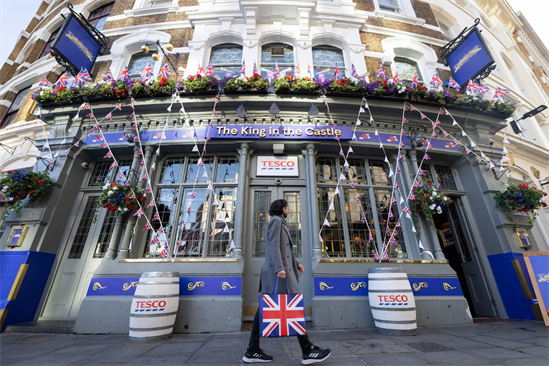

Brand
Tesco
"Every little helps."
-
Established
1919
-
Number of staff
>500,000
-
Head office
Welwyn Garden Cit, UK
-
Sector
Supermarkets
Tesco "The King in the Castle" by Splendid Communications
Tesco "The Christmas Party" by Bartle Bogle Hegarty London
Tesco Mobile "Supermarket mobile" by Bartle Bogle Hegarty
LATEST
About Tesco
Tesco is the ultimate story of a London boy made good. Jack Cohen founded the brand from a market stall in 1919 and, in true British fashion, his first own-brand product sold was Tesco Tea, before the company was even given this name formally. The brand name comes from merging initials of TE Stockwell – a partner at his tea supplier – and the first two letters of Cohen’s surname. The first Tesco store opened its doors in Burnt Oak, North London, a decade later, selling dry goods. From then on, the business went from strength to strength, opening more stores in North London and the suburbs. The company floated on the London Stock Exchange in 1947.
Its expansion continued apace, with 500 stores opening between 1955 and 1960 and the purchase of 212 Irwin stores in northern England. In fact, it’s claimed that the first time the term ‘superstore’ was used was in reference to Tesco’s Crawley store, which opened in 1968. The retailer now has 3535 stores in the UK and 6814 worldwide.
From the 1960s, the supermarket started selling general household goods as well as clothing. Computerised checkouts were introduced in 1982, the Tesco Value range in 1993 and catalogue service Tesco Direct in 2006.
In the run-up to the millennium, Tesco was ubiquitous in British family life and its stranglehold on the UK retail market seemed unassailable: Tesco served 44% of all UK households in 1998, 6% more than its nearest rival at the time, Sainsbury’s, according to a report by TNS. Soon, we were not just buying our groceries from the UK’s biggest supermarket, we were also using Tesco for our banking (Tesco Bank was founded in 1997), phones (Tesco Mobile, founded 2003), broadband (launched 2004), and to furnish our homes and sell us computers.
One of the keys to its success over this period was the use of data via the ClubCard loyalty programme (developed and managed by Dunnhumby, launched in 1995), which used information from millions of shoppers to plan product launches and personalise communications.
Nevertheless, there were signs that the brand was starting to slip. For instance, it became embroiled in furious price wars with competitors and there were clues that its value-based positioning was beginning to harm the Tesco brand. It also faced criticism that it had become complacent, and key criteria such as the shopping experience had begun to be neglected. The most telling shift was when shoppers voted with their feet, choosing newer challengers such as Aldi and Lidl instead. Indeed, former Tesco chief executive Sir Terry Leahy told the BBC’s Panorama programme, Trouble At Tesco, that the failure to offer customers the best deals had led to a lack of trust and shoppers going elsewhere.
In 2014, Tesco posted its biggest UK loss to date, plunging £6.5bn into the red following an accounting scandal. Marketing has been shaken up in a bid to turnaround the brand’s fortunes, reviving the famous ‘Every little helps’ tagline with a pledge to prioritise customer experience.
BUSINESS DETAILS
Tesco House, Shire Park, Kestrel Way, Welwyn Garden City, Hertfordshire AL7 1GA
www.tesco.co.uk
KEY PEOPLE
Michelle McEttrick, group brand director
Alex Brittain, marketing director
Robin Terrell, chief customer officer
Toby Horry, digital marketing director







-2.png)




